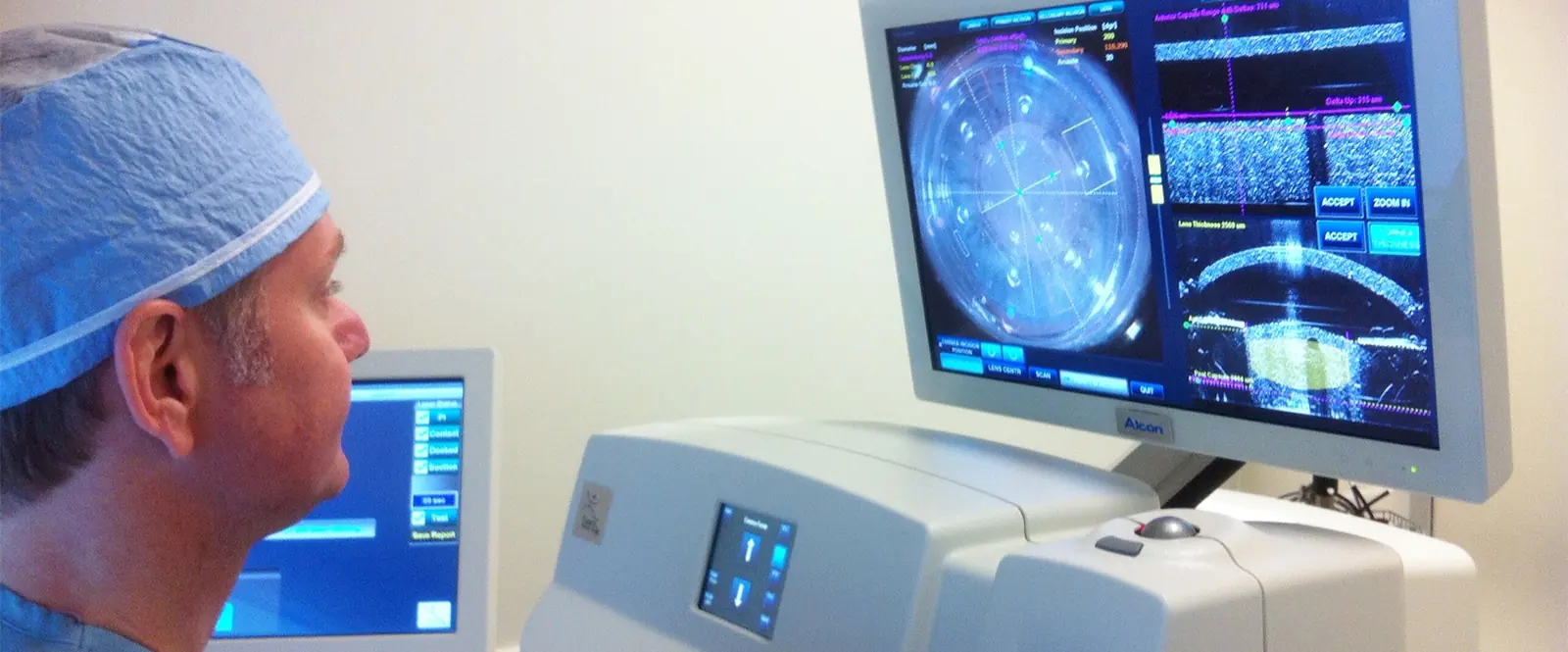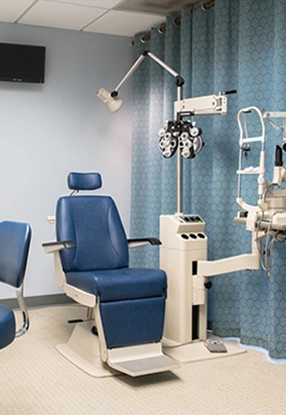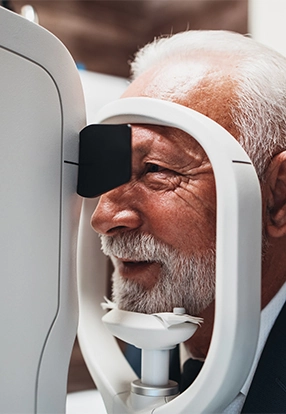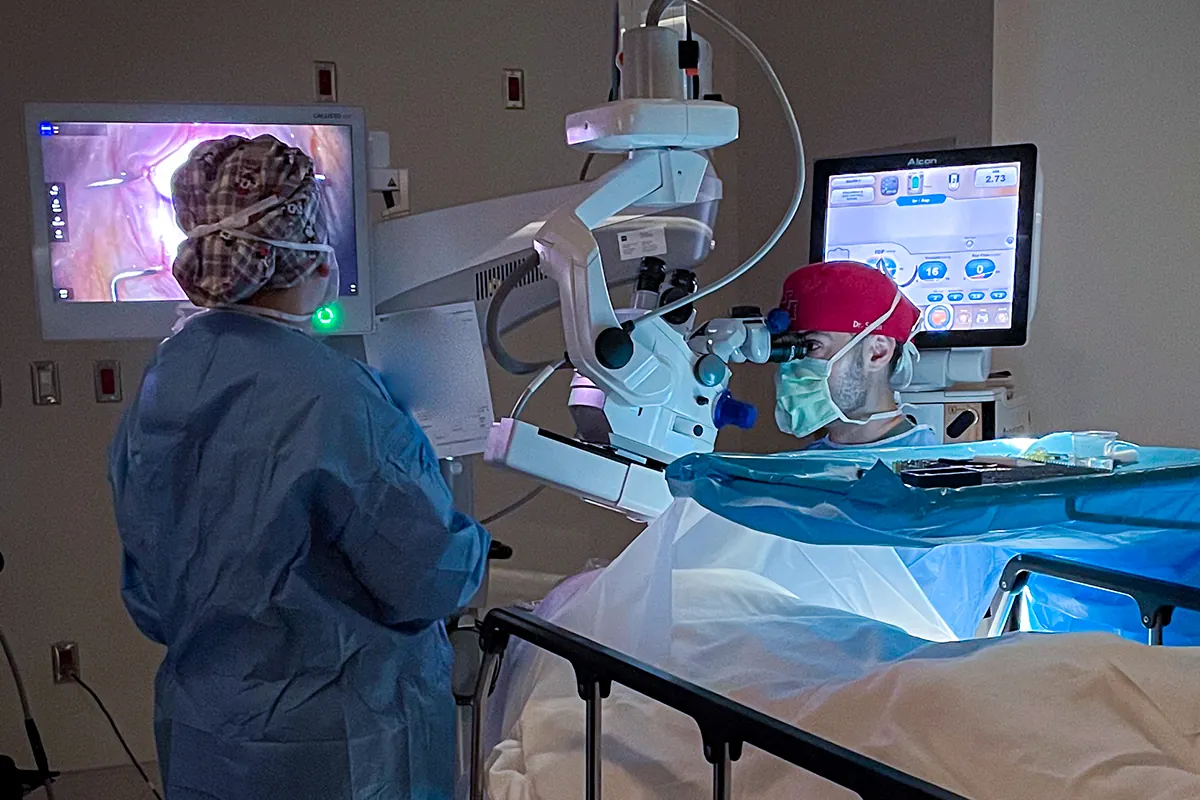At Diagnostic Eye Center in Houston, TX, our ophthalmologists use the latest technology to perform bladeless, customized cataract surgery. We also offer a full range of advanced intraocular lens (IOL) options to help our patients achieve clearer vision after cataract surgery.
- What is a Cataract?
- Bladeless Cataract Surgery
- Increased Precision With The ORA™ System
- Customized Intraocular Lens Options
- Cataract Surgery: What To Expect
- Preparing For Cataract Surgery
- The Cataract Surgery Procedure
- Recovery After Cataract Surgery
- Secondary Cataracts
- Frequently Asked Questions About Cataracts
What is a Cataract?
A cataract is a term used to describe clouding of the natural lens inside the eye. In young people, the lens is not only clear, but flexible. The flexibility of the lens allows it to change focus for objects at different distances much like a camera does, meaning that vision at both far and near is sharp. As we enter our 40’s, the lens begins to change. It becomes less and less flexible with every passing year, resulting in the gradual near vision loss over time. It also becomes more cloudy.
Once the lens clouds enough to affect vision, it is called a cataract. This process is a normal and expected part of aging — every single one of us will eventually develop this condition if we live long enough. There is no good medical treatment for cataracts — the only treatment for cataracts is surgical removal of the cloudy lens and replacement with a clear Intraocular Lens (IOL) implant. According to the National Eye Institute, more than one-half of Americans will require cataract surgery by the time they are
Trusted Source
Cataract Data and Statistics
National Eye Institute
Go to Source
75 years old
.

Bladeless Laser Cataract Surgery
Laser Cataract Surgery offers the most precise and predictable visual outcomes available, and our surgeons at Diagnostic Eye Center in Houston are proud to offer this revolutionary technology to our patients. While traditional cataract surgery is a safe and successful procedure, the LenSx® Laser replaces many of the steps previously done by hand, increasing the level of precision during the surgery and allowing our surgeons to achieve better results than ever before.
Benefits to our patients include:
- Astigmatism Correction. In an eye that has astigmatism, the vision is blurred because the cornea (front surface of the eye) is shaped more like a football than a basketball. The LenSx laser can reduce small amounts of astigmatism by reshaping the cornea, resulting in better vision without eyeglasses.
- More Precise and Customized Corneal Incisions. In traditional cataract surgery, the surgeon makes tiny incisions on the front of the eye with a small blade. Using the innovative technology of the LenSx Laser to make these incisions provides greater precision and control.
- Automated Cataract Fragmentation and Easier Removal. The laser fragments the cataract into pieces and softens it. You can think of it like putting a cookie in the microwave for a few seconds or dipping it in milk, making it soft and crumbly. This makes removal faster and easier.
- Faster Recovery Times. Because the LenSx Laser fragments and softens the lens, less ultrasound energy is needed to remove it. This results in less swelling and faster visual recovery.
- Better Intraocular Lens Placement. One of the greatest capabilities of the LenSx Laser is its pristine and reproducible capsulorhexis formation, which creates an opening in the lens capsule to allow access to the cataract. The laser makes this opening as a perfect circle with the exact same size and position every single time. This allows more precise placement of the intraocular lens and ultimately more predictable visual outcomes.
Increased Precision With The ORA™ System
In addition to the LenSx laser, we also employ the ORA System with VerifEye Technology™ to optimize results after cataract surgery. The ORA System can be used for all cataract surgery patients, but it is especially beneficial for patients who have undergone previous refractive surgery, such as LASIK, PRK, or RK. These patients have altered corneal curvatures, which have traditionally caused challenges when calculating the power of the intraocular lens to be placed inside the eye.
By using the ORA System, our cataract surgeons can now take multiple instantaneous measurements to ensure proper lens selection. The benefits of the ORA System include:
- Increased accuracy of lens power selection
- More precise astigmatism correction
- Improved visual outcomes
“I’ve gone to Diagnostic Eye Center for over 20 years for glasses and just had cataract surgery on both of my eyes. It was the most positive experience I’ve had and the care and consideration I was given was outstanding! If you want expert care and I’m sure you do, call Diagnostic Eye Center and receive the best there is in Houston.”
During cataract surgery, the cloudy natural lens of the eye is replaced with an artificial intraocular lens, or IOL. Standard, or monofocal IOLs are covered by insurance and can correct near or distance vision, but not both. For our patients who wish to achieve even better vision after cataract surgery, we offer a range of advanced IOLs.
Intraocular lens (IOL) technology is continuously advancing, which means that our surgeons can offer a more customized surgical plan to give you the best visual results for your lifestyle. Every patient is different, and our doctors will take the time to understand your unique visual needs and help you choose the best intraocular lens for your eyes. If you are motivated to reduce your dependence on eyeglasses and contact lenses, ask your surgeon if you are a candidate for an advanced technology IOL.


Cataract Surgery: What To Expect
Preparing For Cataract Surgery
The first step in preparing for cataract eye surgery is to attend a consultation with an ophthalmologist at Diagnostic Eye Center. During this meeting, your eye doctor will confirm your cataract diagnosis and help you choose the right type of IOL for your unique needs and lifestyle. Once your procedure is scheduled, you will be given detailed pre- and postoperative instructions.
Please note that you will not be able to drive yourself home after cataract surgery, so you’ll need to make arrangements for transportation.


The Cataract Surgery Procedure
At our Houston Clinic, cataract surgery is performed as an outpatient procedure and only takes about ten to fifteen minutes. Patients are given mild oral or IV sedation, and eye drops are used to numb the eye. Our surgeons first use the LenSx femtosecond laser to make small incisions on the front of the eye, to create an opening in the capsule to access the cataract and to correct small amounts of astigmatism. Then in the operating room, the clouded lens is removed using a procedure called phacoemulsification, which involves an ultrasonic probe that dissolves the cataract. An intraocular lens implant is then placed inside the eye.
Recovery After Cataract Surgery
Following cataract surgery, patients are fitted with an eye shield to protect their eye as it heals. This should be worn while sleeping or lying down. Patients use antibiotic and anti-inflammatory drops for about four weeks. Strenuous activity should be avoided for one week, but most patients return to a desk job the day after surgery.
Secondary Cataracts
The term “secondary cataracts” is often used for blurry vision after cataract surgery, but this isn’t entirely accurate. Once a lens of the eye that has been clouded by cataracts has been removed and replaced, cataracts won’t come back.
After surgery, many patients develop a haze in the membrane behind the intraocular lens (IOL) implant, causing blurred vision and glare at night. This common condition, known as posterior capsule opacification (PCO), is sometimes referred to as a “secondary cataract” due to the similarity of symptoms. Cataracts, however, never recur following surgery. PCO is easily treated with a quick and painless procedure called a YAG Laser Capsulotomy.
Common Questions about YAG Laser Capsulotomy
Posterior capsule opacification may be thought of as a scarring process that occurs in the capsule, or bag, which contained the natural lens of the eye. During cataract surgery, this capsule is left in place to hold the new intraocular lens implant. Proliferation and migration of lens epithelial cells onto the capsule after cataract surgery cause an obstruction of vision. Posterior capsule opacification is not preventable, but it is easily treatable.
Posterior capsule opacification may be treated with a minor laser procedure known as a YAG Laser Capsulotomy.
YAG stands for Yttrium, Aluminum, and Garnet crystals used to generate the laser.
No, it is much simpler and faster than cataract surgery. No anesthesia is required. Once you arrive at our Houston surgery center, the eye is dilated. Your surgeon then uses a laser to create a central opening in the hazy capsule located behind the intraocular lens implant.
The procedure takes only a few minutes.
No. You will hear small clicks or pops, but because the capsule has no pain fibers, the procedure is entirely painless.
Patients may resume normal activities immediately. Most patients notice visual improvement within a day of having a YAG Laser Capsulotomy.
Patients should anticipate some “floaters” in their vision following this procedure, which will likely resolve within a few weeks. Serious side effects are rare.
Frequently Asked Questions About Cataracts
Can cataracts be prevented?
There is no way to prevent cataracts, but it may be possible to slow their development or progression by protecting your eyes from UV light and eating a healthy diet.
Is cataract surgery painful?
No. Anesthetic eye drops will be applied to help you stay comfortable during the cataract surgery procedure. Pain should not be part of your experience during the procedure or during the recovery period.
What are the risks of cataract surgery?
Fortunately, the rate of complications from modern cataract surgery is very low. Your surgeon will discuss possible complications and side effects with you at the time of your consultation.
Rare risks of cataract surgery may include:
- Infection
- Inflammation
- Halos
-
Trusted Source Cataract Surgery Mayo Clinic Go to Source Retinal detachment
Will insurance cover my cataract surgery?
Once cataracts have progressed to a stage where a patient’s vision is impeded, cataract surgery is deemed medically necessary and eligible for insurance coverage. Standard, monofocal IOLs are included in insurance coverage for cataract surgery, but patients may incur out-of-pocket expenses if they opt for advanced IOLs.
Dr. Salem Answers Cataract Surgery Questions
What is a cataract?
1 National Eye Institute. Cataract Data and Statistics. Available: https://www.nei.nih.gov/learn-about-eye-health/resources-for-health-educators/eye-health-data-and-statistics/cataract-data-and-statistics. Accessed October 31, 2022.
2 Mayo Clinic. Cataract Surgery. Available: https://www.mayoclinic.org/tests-procedures/cataract-surgery/about/pac-20384765 Accessed October 31, 2022.
The doctors at Diagnostic Eye Center have reviewed and approved this content.


